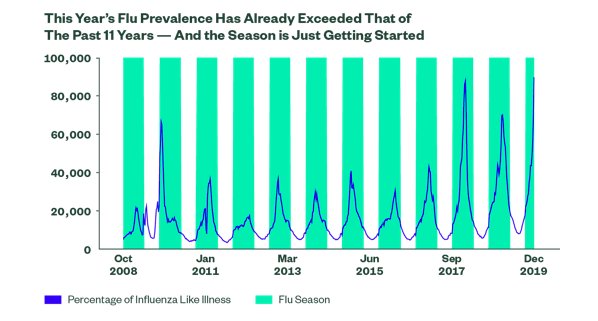Michael Arone, CFA, Chief Investment Strategist, State Street Global Advisors
This article was written with contributions from Charlotte Irwin. Charlotte is a Research Strategist on the ETF and Mutual Fund Research Team.
The flu causes substantial mortality and loss of productivity in the US each year.The flu is responsible for an estimated average $10.4 billion in direct medical costs and over $16 billion in lost earnings each year. The timing of this flu season could add to pressures on the US consumer.
It’s that time of year. After relaxing holiday breaks spent visiting with family and friends, everyone’s back in the office full of unbridled optimism – and germs. And all the ensuing coughing, sniffling and shivering can mean only one thing: It’s flu season.
While the flu circulates all year, activity generally peaks from December through February. And with between 4.6 million and 6.6 million people already stricken, the CDC has warned that this season is on track to be as severe as 2017-2018, when 45 million flu cases made that season one of the deadliest in a decade. Given that the US economy has recently relied so heavily on consumer strength, too many sick days could drag on already slowing growth.
Good news, bad news
So far, the two major measures of the flu’s severity — hospitalizations and deaths — remain modest. However, the flu could spread rapidly and intensify in the coming weeks, especially because this season’s flu vaccine is no match for the viral strain now dominating flu activity across the US.
Even when vaccine development correctly anticipates the circulating viruses, the flu shot’s effectiveness is only about 60%. In comparison, the measles vaccine is 97% effective with two doses.1
The abnormality of this flu season is that the B strain of the virus, which typically doesn’t surface until the end of the season, is currently causing the illness in most parts of the country. More typically, the A strain of influenza dominates the early months. The upside is that strain B poses less of a danger than the more common A strain does to people 65 and older, who generally make up the majority of flu hospitalizations and deaths. However, the unusual early appearance of strain B flu has sickened many children.2

Source: State Street Global Advisors, Centers for Disease Control, Bloomberg Finance L.P., as of December 27, 2019.
Calculating flu costs
Today, between the flu vaccine, antiviral medicines developed to lessen flu symptoms, and the ever-increasing array of over-the-counter cold medications, most of us view the flu as a miserable but manageable illness. However, it is responsible for substantial mortality and loss of productivity in the US each year. The CDC reports that since 2010, the flu has resulted in 9 million to 45 million illnesses, 140,000 to 810,000 hospitalizations and 12,000 to 61,000 deaths annually.
Given that the CDC reports that roughly 60% of flu illnesses occurred within the working age (18-64) population from 2010 to 2016, lost wages and productivity are also concerns. In fact, US employees miss more than 111 million workdays a year due to the flu. Those numbers are unlikely to decline, because many adults remain unvaccinated. Vaccination coverage varies by state, according to the CDC, ranging from 33.9% to 56.3% among adults and between 46.0% and 81.1% for children.3
The most comprehensive study of the flu’s impact on the US economy was published in 2007. It found the flu responsible for an average of $10.4 billion in direct medical costs and over $16 billion in lost earnings each year. That resulted in an average total annual economic burden of more than $87 billion for the US economy. And in some years, the cost hit $150 billion.4
Pressuring the US consumer
Will the flu trigger a recession? Absolutely not. But the flu’s severity and timing could add to the pressures building on the US consumer — especially as the flu tends to hit hardest early in the new year, after the hefty deductibles on the increasingly prevalent higher deductible insurance plans have reset.
Lower taxes also support today’s consumers, as they did in the 1920s. While taxing personal income had just begun in 1913, tax rates dramatically increased in 1918 to fund the war effort. Post-armistice, most agreed that the rates were too high, though there was sharp disagreement on what they should be. That sounds familiar. Democrats wanted to cut tax rates for low-income taxpayers and maintain a steep progressive scale, while Republicans favored sharper cuts and less progressive tax rates. In the end, the highest marginal tax rate was reduced three times in quick succession – from 73% to 58% to 46% and, finally, to 25% for the 1925 tax year. Other rates were also reduced, and exemptions were increased.
Click here to read the entire article, which first appeared on December 18 on the SPDR blog.
Photo Credit: Dominic Alves via Flickr Creative Commons
Footnotes
1 Lena H. Sun, “Unusual Flu Virus Is Hitting Children Hard, And This Season’s Vaccine Is a Poor Match,” The Washington Post, January 10, 2010
2 Lena H. Sun, “Unusual Flu Virus Is Hitting Children Hard, And This Season’s Vaccine Is a Poor Match,” The Washington Post, January 10, 2010.
3 CDC, Flu Vaccination Coverage, United States, 2018–19 Influenza Season.
4 “The annual impact of seasonal influenza in the US: Measuring disease burden and costs,” Vaccine, June 28, 2007.
This material is from State Street Global Advisors and is being posted with State Street Global Advisors’ permission. The views expressed in this material are solely those of the author and/or State Street Global Advisors and Interactive Advisors is not endorsing or recommending any investment or trading discussed in the material. The opinions expressed may differ from those with different investment philosophies. This material is not and should not be construed as an offer to sell or the solicitation of an offer to buy any security. To the extent that this material discusses general market activity, industry or sector trends or other broad-based economic or political conditions, it should not be construed or relied on as research or investment advice. To the extent that it includes references to specific securities, commodities, currencies, or other instruments, those references do not constitute a recommendation to buy, sell or hold such security. This material does not and is not intended to take into account the particular financial conditions, strategies, tax status, investment horizon, investment objectives or requirements of individual customers. Before acting on this material, you should consider whether it is suitable for your particular circumstances and, as necessary, seek professional advice.


